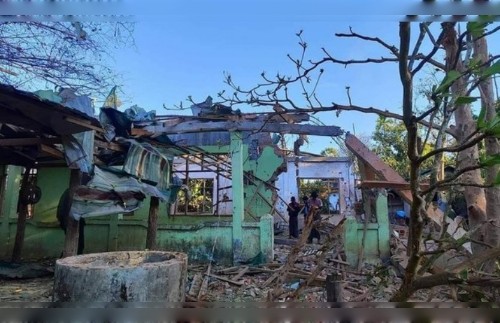Heather Murdock

When the blast went off in early April, shrapnel hit homes and schools all over the quiet residential neighborhood of the Yemeni capital.
Windows shattered and the 2,000 girls in a nearby school tried to evacuate at once, many racing down the stairs and some dying in the stampede.
Safia Al-Wesabi, a 10-year-old student of the Al-Ra’ai School, made it out safely, but she couldn’t find her older, teenaged sister outside. “I was sobbing,” she said. “I thought she was trampled to death.”

More than 15 children were killed and 100 other people injured that day, but violence is just one of the many reasons the war in Yemen has crippled the country’s ability to educate children, and often even keep them alive. As Yemen’s conflict goes into a fifth year, aid organizations are calling it a “war on children.”
“We are at a tipping point,” said Henrietta Fore, the executive director of UNICEF in a recent speech. “If the war continues any longer, the country may move past the point of no return…How long will we continue allowing Yemen to slide into oblivion?”
Missing school and health care
As the children fled flying glass and shrapnel at their school last month, Hamid Al Wesabi, Safia’s father, was in his home located on a hill nearby. His house shook and the windows broke. He ran to the school to find his daughters. “We didn’t know what was happening,” he said.
Later that day, both the girls and their father escaped the chaos and reunited at home.
A few weeks later, the school was open again for final exams and Wesabi’s daughters went back. Many others chose not to return.
At least one in five schools is no longer in use in Yemen, mostly because they were destroyed by violence or are now being used as emergency shelters or military bases.
Hospitals also have shut down at alarming rates and roughly half of Yemeni children under age 5 have already been permanently injured by malnutrition. Every 10 minutes a child in Yemen dies from a preventable cause, according to a recent UNICEF report.
Teachers’ salaries are often not being paid, forcing many to look for other jobs. Sometimes children are simply too afraid to go to school, the report says.
As a result, Yemeni children are increasingly recruited to fight in militias, work at other adult jobs or married off at young ages. “If not in school, children would become an illiterate and unskilled parent and increasing the likelihood of passing on poverty to the next generation,” it reads.
Safia took her exams but her text books were lost in the blast, so she could not prepare.
Other children were not so lucky. Sitting next to Safia at a wooden desk, 8-year-old Bayan appeared absent-minded when asked about her older sister, who was killed in the crush of girls trying to escape. An adult asked if she missed her sister.
“Yes,” she managed to say quietly.
Humanitarian crisis deepens
The war in Yemen is between the Houthis, who currently hold the north, including the capital Sana’a, and forces loyal to the government of Abd-Rabbu Mansour Hadi, who was forced from the capital in 2015 and is recognized as the Yemeni president by the United Nations.
These are hardly the only players in this war, which has left many world powers mired in proxy battles. Iran is known to support the Houthis, whose longest-held territories are near the border with Saudi Arabia, Iran’s archenemy.
Saudi Arabia and its allies have been launching airstrikes targeting the Houthis — often in locations populated by civilians — for four years now with support from Western powers like the United States and Britain. Tens of thousands of people have been killed, many of them civilians, including children.
Already the Arab world’s poorest country, this battle has turned Yemen into what many call the world’s worst humanitarian disaster, with the threat of widespread famine now looming as peace talks continue to be derailed. Last week, a cease-fire in a key port city broke down, exacerbating the threat as food and aid remained stalled outside the country by the war.
It is not clear as to who or what caused the blast that hit the school last month, with pro-Saudi news reporting an airstrike, and later deleting the report, according to Human Rights Watch.The organization says Houthi authorities were storing dangerous material in a civilian neighborhood.
Besides violence, hunger, and disease, children in Yemen are also deeply threatened by the psychological trauma they are experiencing, according to Fathia al-Kuhlani, the principal of the Al Ra’ai School in Sana’a.
“After trauma, if students don’t go back to school, anxiety can lead to depression,” she said. “It was hard even for us to enter the school the day after the strike, but we needed to come to encourage the students to come back.”
















